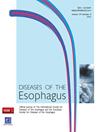425. PARACONDUIT HIATAL HERNIA FOLLOWING ESOPHAGECTOMY IN A PORTUGUESE TERTIARY CENTER
IF 2.3
3区 医学
Q3 GASTROENTEROLOGY & HEPATOLOGY
引用次数: 0
Abstract
Background Esophageal Cancer is the seventh most common cancer worldwide with poor overall survival. As minimally invasive esophagectomy is becoming the new standard of care, an increased incidence of para-conduit hiatal hernias has been reported. Possible risk factors, other than those related to the operative approach have been suggested, such as location of the tumor. Histological type may also account for the increased incidence of hiatal hernias due to shift from esophageal squamous cell carcinomas to adenocarcinomas of the gastro-esophageal junction in Western world. We reviewed our center’s experience to determine whether the adoption of minimally invasive esophagectomy was associated with an increased incidence of para-conduit hernia. Methods A single-center, prospective database was used to retrospectively analyze consecutive patient who underwent esophagectomy between January 2007 and December 2023. Results Between January 2007 and December 2023, 497 patients were submitted to esophagectomy (Ivor-Lewis, McKeown or transhiatal) due to cancer (242 squamous cell carcinomas and 255 adenocarcinomas); 163 proximal esophageal cancers and 323 distal esophageal cancers. An hiatal hernia was diagnosed in 11 (2.21%) of 497 included patients submitted to esophagectomy; 5 (3.25%) after 154 totally minimally invasive esophagectomies, 3 (11.11%) after 27 hybrid esophagectomies and 3 (0.95%) after 316 open esophagectomies. The median days to diagnosis of hiatal hernia was 199 (6-3881) days. Surgical treatment consisted of cruroplasty in 1 patient, crurorrhaphy in 6 patients, reduction of herniated contents in 4 patients. The tumor was located proximally in 1 patient whereas the remaining 10 were at distal esophagus or at gastro-esophageal junction. Regarding pathologic evaluation, 2 were squamous cell carcinomas (0.82%) and 9 adenocarcinomas (3.53%). Conclusion In our experience, the adoption of minimally invasive esophagectomy has been associated with an increase of symptomatic para-conduit hernia, in line with the reports of recent meta-analyses. The prevalence of paraconduit hiatal hernia was also increased in adenocarcinomas, revealing the shift in the histological type in Western world. The true rate of herniation may be much higher, as our patients are not routinely submitted imaging diagnostic tests as part of their follow-up.425.葡萄牙一家三级医疗中心食管切除术后的食管旁裂孔疝
背景 食管癌是全球第七大常见癌症,总体生存率较低。随着微创食管切除术逐渐成为新的治疗标准,有报道称导管旁食管裂孔疝的发生率有所增加。除了与手术方法有关的因素外,还有其他可能的风险因素,如肿瘤的位置。组织学类型也可能是食管裂孔疝发病率增加的原因,因为在西方国家,胃食管交界处的肿瘤已从食管鳞状细胞癌转变为腺癌。我们回顾了本中心的经验,以确定微创食管切除术的采用是否与导管旁疝发病率的增加有关。方法 使用单中心前瞻性数据库对 2007 年 1 月至 2023 年 12 月间接受食管切除术的连续患者进行回顾性分析。结果 2007年1月至2023年12月期间,497名患者因癌症(242例鳞状细胞癌和255例腺癌)接受了食管切除术(伊沃-刘易斯、麦基翁或经食管);其中163例为近端食管癌,323例为远端食管癌。在接受食管切除术的 497 例患者中,有 11 例(2.21%)确诊为食管裂孔疝;其中 5 例(3.25%)是在 154 例完全微创食管切除术后确诊的,3 例(11.11%)是在 27 例混合食管切除术后确诊的,3 例(0.95%)是在 316 例开放食管切除术后确诊的。确诊食管裂孔疝的中位天数为 199 天(6-3881 天)。手术治疗包括 1 名患者的嵴成形术、6 名患者的嵴切除术和 4 名患者的疝内容物切除术。1 名患者的肿瘤位于食管近端,其余 10 名患者的肿瘤位于食管远端或胃食管交界处。病理评估结果显示,2 例为鳞状细胞癌(0.82%),9 例为腺癌(3.53%)。结论 根据我们的经验,微创食管切除术的采用与无症状旁导管疝的增加有关,这与最近的荟萃分析报告一致。在腺癌中,旁凹食管裂孔疝的发病率也有所上升,这揭示了西方国家组织学类型的转变。真实的食管裂孔疝发生率可能要高得多,因为我们的患者在随访过程中并未常规接受影像诊断检查。
本文章由计算机程序翻译,如有差异,请以英文原文为准。
求助全文
约1分钟内获得全文
求助全文
来源期刊

Diseases of the Esophagus
医学-胃肠肝病学
CiteScore
5.30
自引率
7.70%
发文量
568
审稿时长
6 months
期刊介绍:
Diseases of the Esophagus covers all aspects of the esophagus - etiology, investigation and diagnosis, and both medical and surgical treatment.
 求助内容:
求助内容: 应助结果提醒方式:
应助结果提醒方式:


